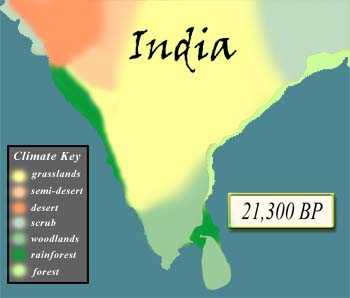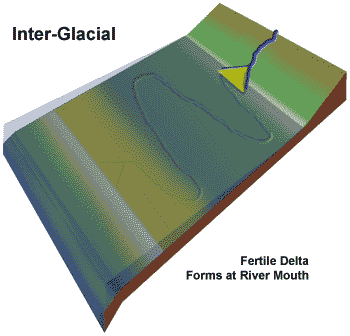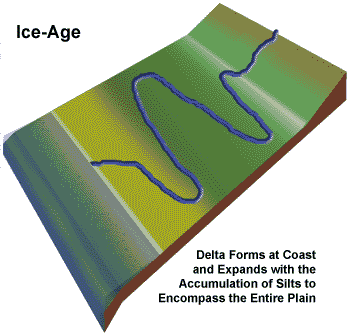In the first of a series of articles addressing the relationship between coastal flooding and the origins of agriculture, Christopher discusses the central problem of Underworld’s model of pre-historic cultural history and points out what may be a clue to its resolution.
Part 1: The Great Flood(s)
Graham Hancock, in his latest book, Underworld, proposes that a number (unknown) of sophisticated, urban civilizations disappeared at the close of the Ice Age. A catastrophic rise in global sea level at that time, according to Hancock, had fatal consequences for these maritime peoples, as the lands upon which they had chosen to settle were just those lands most susceptible to flooding. Thus, the disaster that eliminated their culture also destroyed all obvious trace of their existence.
As all of Hancock’s hypothesized Ice Age civilizations are alleged to have followed a similar settlement pattern — with the exception of the Jomon culture of Japan (the pre-history of which, according to Hancock, is more complex) — his detailed exposition of India’s pre-history exemplifies the model Hancock proposes for the globe. Thus, through the sub-continent, we can view the effect of ocean inundation activity on the planet in microcosm.
On pages 262-263 of Underworld, Hancock reproduces a series of maps that show the landmass of India over a breadth of 14,400 years. In eight quick steps, these “inundation maps” take us from the water’s low point, 21,300 years ago, to its present high point, which occurred 6900 years ago (these maps have been reproduced here as an animation). It is easy to sweep one’s eyes over these panels and imagine a time-lapse film revealing the deluge, washing up over the land.
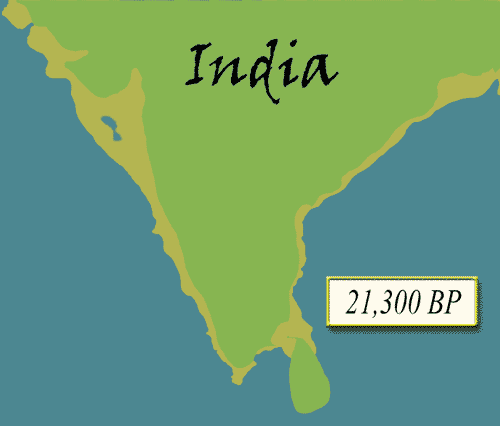
From this series of stills however, it is immediately apparent just how relatively small a portion of the Indian land mass was affected by flooding. If the maritime character of Hancock’s model civilization sufficiently explains the absence of evidence in its favor, from inland areas, it is less useful in explaining why positive evidence is similarly lacking in those coastal regions remaining largely static during the key post-Ice Age period.
Aside from some minor incursion, nearly the whole of India’s eastern seaboard remains perfectly recognizable from the last glacial maximum (LGM) through to the present day. In fact, only the Indus valley and a narrow strip of land down the western coast of India suffers measurably from land loss. This certainly complicates matters for Hancock, for he must restrict his hypothesized Ice Age urbanites not to the coasts, but to specific coasts – and Hancock must do this all over the globe if his thesis is to (excuse the pun) hold water.
As Hancock himself states the problem on page 155,
Even in the unlikely event that a culture that was a little out of the ordinary had existed at that time [8,000 to 11,000 BP]…why should it have chosen to concentrate itself in the very part of India that would suffer the most extensive post-glacial inundations – when there were so many other parts of India to choose from?
Hancock simply cannot explain why these ancient urban cultures were so unfortunate as to have settled exclusively in areas fated for inundation at the end of the Ice Age. To his credit, Hancock admits this poses a problem for his scenario. Perhaps in an effort to avoid embroiling himself in defending inadequate solutions, he (wisely) avoids giving any at all. Hancock merely begs the reader’s indulgence and puts forth a model for cultural development that, though substantiated by some measure of evidence, relies on “bad luck” as its basis.
At the risk of proposing just such an inadequate solution, I suggest that Hancock’s own data reveals a more plausible and significantly more substantial agent for this scenario than “bad luck.”
Hancock assumes the reason archeologists find no evidence for his antediluvians on dry land is because no evidence is there for archeologists to find. If this assumption is safe (and I think it is), the only certain, common characteristic of Hancock’s antediluvian civilizations is that their peoples chose to settle exclusively on lands fated for post Ice Age inundation.
Might there then be something unique about these areas that could facilitate or encourage cultures of this type: something, the absence of which, would have discouraged permanent settlement elsewhere?
The maps on pages 262-263 of Underworld may provide us with a clue.
The most apparent unique quality of the area in which our Ice Age ancestors are alleged to have settled is the one quality identified by Hancock himself: the land was flooded at the end of the Ice Age. However, unless the laws of cause and effect are to be reversed, future flooding could not possibly produce better living conditions in the past.
Or could it?
The Vedas of India tell us that the universe moves in cycles; where tomorrow’s cause is yesterday’s effect. Let us then follow their advice and examine the maps of pages 262-263 of Underworld again, but this time, reversing the flow of time.
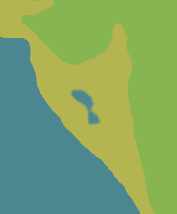
Tracking our eyes backward across the eight panels, the time-lapse film reverses, taking with it the waters of the ocean and revealing dry land where once water had been (this reversed flow has been reproduced here as an animation). The film may be played in the mind several times and each time we see the reverse of nature’s destiny: ending each time, not with a flood, but with dry land.
There, quite possibly, is the explanation we seek: a single factor that can explain both the location and the eventual destruction of Hancock’s antediluvians.
The fact is, we need not appeal to metaphysical theosophy to wrap time in a circle, when science tells us just how cyclic nature has proven to be.
130,000 years ago, a great deluge washed over the entire globe at the end of an Ice Age. This was the birth of the “Eemian Interglacial Era,” a time not unlike our own “Holocene (presumably inter-glacial) Era.”
For 30,000 years, until 100,000 years ago, the earth basked in the sun’s warmth and the oceans swelled to even greater fullness than do our own (six or seven meters higher).
Then, suddenly, it all came to an end, as gigantic Ice Caps formed in the earth’s high arctic and swept down over the great continents, pushing our ancestors and the beasts with which they shared the planet into the close confines of the equatorial regions.
With the birth of the last great Ice Age, the floodwaters of the Eemian receded, leaving dry land where once there were great seas (see animation).
So it is that the one unique quality of the land that once would be flooded is that it once was flooded. As we shall see in subsequent sections, this one unique quality may well be the single factor to have both fostered early civilization and sealed its fate.
In part one of this series, Christopher Ash suggested that Eemian Inter-Glacial flooding of coastal lowlands (the same coastal lowlands that now lie under water during our current Holocene Era) may hold the key to explaining the settlement patterns Hancock claims for his hypothesized, first urban Ice Age culture. Now, in part two, Christopher continues the discussion with a dissection of Hancock’s understanding of Ice Age lowland conditions, as outlined in Underworld.
Part 2: The Silt Solution
In Underworld, Graham Hancock accounts for the exclusive, seashore settlement of his pre-historic urbanites with only the barest outline of an hypothesized, environmental push-pull scenario.
In his notes for Chapter Three, entitled Meltdown, Hancock writes:
E.g. scenario: Population is tempted to migrate to coasts, or to low-lying valleys near coasts, by improved conditions; several thousand years of stability and prosperity; all eggs placed in the basket of the coastal cities; flooding suddenly resumes and engulfs the cities; there are only a few survivors etc.
Again, on page 272 of Underworld, Hancock tantalizes us with the following speculation…
…many of the coastal lands that were inundated would have offered desirable refugia from inhospitable and unpredictable Ice Age conditions….
Nowhere does Hancock provide detail for what constituted these “improved conditions.” In fact, in neither instance does he explain why his hypothesized Ice Age peoples would have placed “all eggs in the [coastal city] basket.”
Nevertheless, his essential premise is clear: “inhospitable” conditions in inland areas pushed early humans toward the seas while “desirable” conditions along the “coastal lands” pulled the population in the same direction. Hancock does not detail the nature of either variable: neither what accounted for the supposed hostile conditions of the inland areas nor what constituted the attractive qualities of the coastal plains.
The closest Hancock comes to offering a cognizant explanation for the above scenario is to suggest that the outer extremities of rivers, especially river deltas, proved particularly attractive to the first urban humans (Deltas are formed from the deposit of sediment, transported by rivers).
In a discussion of Taiwan in on page 635 of Underworld, Hancock writes:
These long-lost coastal plains [between Tiawan and the Chinese Mainland, were] fertile with the silt of the Ancient Yangtze and Yellow rivers….
The idea that rich soils deposited by rivers attracted a human presence is certainly plausible and even likely. That a relatively numerous population might have been supported is also reasonable, as there are many examples around the world, both modern and historical, that illustrate the high productive yield of river deltas (even without agricultural exploitation). However, though the melting of the ice caps would doubtlessly have submerged any settlements many Ice Age deltas contained – urban or otherwise – it is questionable whether the attractive qualities of deltas alone can explain the exclusivity of the settlement pattern hypothesized for Hancock’s original urban civilizations.
Historically, civilization does not appear exclusively at river mouths. Many of the greatest ancient cities emerged at points far from the coast – often (as with the biblical “Garden of Eden”) at the headwaters of rivers — quite the last place one would look for a delta. If post Ice Age civilization was possible in areas other than river deltas, without compelling evidence to the contrary, there seems no reason to assume that the rules were much different during the Ice Age – especially in equatorial India where Ice caps and “harsh conditions” might presumably have been relegated to mountain highlands.
Some scientists have argued that the rules in fact were different during the Ice Age: that climate conditions were such that large-scale settlements, supported by inland food sources, were practically impossible.
The “Little Ice Age” of Europe, many have argued, offers us a glimpse of the pre-Holocene, Ice Age environment, and its potential impact upon the food supply (whether grown or gathered).
Between the years 1450 and 1850, the global climate cooled by approximately two degrees (compared with the average nine degree drop that characterized the Ice Age). This period has been described as characterized by…
…repeated famine and cultural dislocation, as many people fled regions that had become hostile even to subsistence agriculture.
If a mere two-degree drop could produce measurable changes in human settlement patterns, we might reasonably expect a nine-degree drop to have had an even more dramatic effect.
If the Ice Age world was one in which only areas of high soil potency had the capacity to produce large quantities of foodstuffs, this would go some way toward supporting Hancock’s scenario. The “push” factor of a harsh worldwide climate might keep urban settlements from encroaching deeply into inland territories while the “pull” factor of relatively rich river deltas could draw human settlers to the shores in search of sustenance.
If we examine the Ice Age climate of India, we find some additional support for Hancock’s scenario (see side bar and animation). The vast expanse of the subcontinent was, at that time, dominated by desert, grassland and scrub. This seems to suggest an environment hostile to food production, both natural and (if anywhere existent) human engineered. Perhaps, now-submerged river deltas may have served as relatively bountiful refugia from this seemingly hostile world (indeed, it must be said that, if conditions in inland India were as harsh as the “Little Ice Age” might indicate, perhaps we ought to be surprised to find anyone at all living there!).
Nevertheless, though Hancock’s scenario appears defensible, it remains somewhat problematic.
Deltas are of limited carrying capacity. Civilizations that have settled on or originated at river deltas have historically tended to spread up the accompanying rivers – in keeping with their expanding population. This was the case with Ancient Egypt, where storage and transportation techniques permitted the outlying Nile delta to become the breadbasket for a community spanning a much larger mass of land (the river itself, providing a ready flow of fertile deposits to human settlers along its shore – even in the heart of what would otherwise have been a desert).
Had a scenario similar to the Egyptian model occurred before the Holocene, remnants of the larger civilization would almost certainly have survived in the archeological record, as glacial melt-water would have submerged only the outward extremities of the great rivers.
Thus, if Hancock’s civilization was born at the river mouths of the Ice Age world, for some unknown reason, it failed to spread up the lengths of the connecting waterways. As this appears to imply a lack of suitable storage and transportation techniques, Hancock’s civilization starts to look a lot less like a sophisticated urban society and more like a populous and (for a time) fortunate group of Paleolithic scavengers that simply stumbled upon a particularly fertile refugia.
Of course, if the particular deltas on which urban developments emerged were limited to those surrounded by large areas of low-lying plains – plains that were destined to sink below sea level – this would assure the extinction of the surrounding population centers supported by the delta bread basket.
Unfortunately, this essentially gets us back where we started: arbitrarily picking and choosing particular oceanfronts for hypothesized antediluvian cities. While the notion of the Ice Age fertile delta might explain to some extent why civilization originally located in the low lands, it appears inadequate, even in the context of climatic data, to explain why civilization failed to radiate up-river and leave its “fingerprints” in the present archeological record.
In part two of this series, Christopher F. Ash suggested that riverine silt deposits and delta systems, as they are popularly understood, offer only a partially satisfying explanation for the settlement patterns Hancock suggests for his early human urbanites. In part three, Christopher presents a revised view of the Ice Age delta, arguing that it represents an ecological “special case.”
Part 3: The Delta Train
…The main difference between the Chinese flood myth and that of Western cultures seems to be the emphasis on why there was a flood. In the Western myths the floods are brought about because of the anger of the gods, or at a whim of the gods, while in the Chinese myth the emphasis is on…the channeling of unruly waters…to make cultivation of the land possible.
One of the traps into which we, as investigators of the past, can easily fall, is to begin our analysis with the modern earth – the one with which we are familiar – serving as the baseline for our analysis. Beginning thus it is all too easy to introduce alien elements, as they are detected, as exceptions to some kind of modern rule.
Were there ice caps in the past? If so, then the earth was “just like today” except for the presence of mountainous glaciers covering the northern continents. Was the ocean water level lower? If so, then the earth was “just like today” except that there was more land. Was the climate dry? If so, then the earth was “just like today,” only a lot less humid.
But how many exceptions do we get to introduce before the earth of the past ceases in any way to be “just like today” and becomes “nothing at all like today?”
In the very few instances where Graham Hancock, in his latest book, Underworld, suggests mechanisms that may have influenced the settlement patterns of early humans, he appears to appeal exclusively to environmental elements present in our modern world, known to have affected the settlement patterns of historical societies. Could it be that, in some ways, Hancock has fallen into the trap of picturing the ancient earth as just like the modern – only different?
Nowhere is this more evident than in his appeal to the historical exploitation of river deltas along the seacoasts, and river silt deposits along low-lying plains, as possible mechanisms for attracting human societies and as producers for the immense food resources urban society requires (a thesis covered extensively in part two of this series). River silt deposits are phenomena that exist in our Holocene world and, in Underworld, no explicit claim is made for any unique Ice Age variant. Hancock’s Ice Age delta appears to be merely a wholesale transplant of the modern delta.
There is nothing inherently wrong with Hancock’s methodology. It is always a good idea to look to the known for clues to the unknown. After all, we have to look somewhere.
However, perhaps we can first look somewhere else entirely: start the investigation by abandoning the modern baseline paradigm and assuming the Ice Age environment to be one utterly alien in character.
The danger with this approach, of course, is that it can give us license to invent an environment that suits the theory. If our cultural development model requires a unique environmental factor (one sufficient to contain the hypothesized antediluvians to specific seacoasts for example), without preconceptions of what is possible and what is not possible, there seems little to constrain us from inventing a special case — thus saving the hypothesis.
Awareness of the danger, of course, is no insurance against its effect. The reader must decide if I fall prey to speculative invention, in the limited reconstruction I now undertake (in this and the next section of this essay) of what is a most unexpected and alien Ice Age world.
The empirical experience of our limited lifetimes on this planet, imparts to us a tendency to imagine earth’s environment as static. That is the first and most powerful effect upon perception the modern baseline paradigm imparts to our conception of the past. The danger is not that we might dismiss the occurrence of dramatic changes in climate occurring over vast periods – all rational observers accept this. The danger is that we might fail to adequately consider the ramifications of the process of change itself.
Because, from our limited perspective, our world appears so stable, it is tempting to fragment the past into psychologically digestible still images, often framed by a geological, climatological, or cultural title (such as “Eemian Inter-Glacial,” “Eocene,” or “Iron Age”). These frames of reference are, as we know, artificial; for in fact, each stage relates temporally and causally to its precedents and antecedents. We all know this and we realize that it would be erroneous to consider each stage in isolation; yet, here too, awareness of the danger offers no insurance against its effect.
Underworld addresses an inter-stage change process in Earth’s climate: the transformation between the Ice Age and Holocene worlds. In his discussion of deltas however, Hancock neglects to consider explicitly how this and other similar change processes might have affected the nature of these river silt deposits. Consequently, he may have overlooked something of great significance.
Or possibly not.
In a discussion of Taiwan in on page 635 of Underworld, as cited in the last installment of this series, Hancock writes:
These long-lost coastal plains [between Tiawan and the Chinese Mainland, were] fertile with the silt of the Ancient Yangtze and Yellow rivers.
This statement is actually a bit ambiguous. Is Hancock referring only to the former, static presence of river deposits and deltas in these once dry lands, or is he implying the presence of something much more significant; something unique to the Ice Age earth?
What is easy to forget, in discussions of ocean level change, is that a process of transformation occurs during the intermediary stages between the ocean’s upper and lower limits. The waterline moves from its low point to its high point and then back again. This movement produces results easy to overlook when one considers each stage in isolation.
One such result of movement in the relative sea level is the formation of multiple deltas.
When the waters of a river move, they carry with them particles of dirt and soil, suspended in the flow. So long as the water is fast moving, most of the particles remain suspended – and indeed, more are added as the river progresses downhill from high ground to low ground.
Gravity is the primary force by which these particles are eventually released from the river’s grasp, but in order for gravity to overcome the inertia of the river’s movement, the water must be slowed. So long as the water cascades over steep inclines, it will not release its silt cargo.
Two mechanisms, when encountered by the water’s flow, are capable of slowing a river sufficiently to cause silt deposits to settle: large bodies of water and wide, flat expanses of land.
When a river rolls over flat plains, it widens – becoming something akin to a long and twisting, ever-moving lake. Its slackened pace allows gravity to overcome the inherent energy of the water, releasing trapped particles to the bottom and to the riverbanks over a wide and long expansive area.
Oceans and lakes, on the other hand, bring a river’s currents to a standstill. This immediate resistance instantly releases suspended matter in a localized space at the mouth of the river. There, like a cement truck laying down pavement, the river expunges its rich, mineral runoff. These fertile paving stones are the building blocks of deltas.
As the location of the seashore determines the base of the delta, changes in ocean depth alter the landside altitude at which deltas arise. As the water level rises and falls, new delta sediments are laid down in each successive location, producing a step pattern of highly mineralized sediment, ascending from the low water mark to the high water mark (see side-bar).
Rising water levels submerge delta sediments and lay down new sediments at higher altitudes. Falling water levels abandon ancient (but still fertile) deltas far from shore, deposit new silts at a lower altitude, and re-expose previously submerged delta sediments (for an illustration of this process, refer to the accompanying animation).
Wherever there is ample continental-shelf space, the low water marks (during the glacial maximums) reveal long trains of deltas, former deltas, and delta deposits, stretching from the ancient coastline all the way to the new shore. The larger and flatter is the shelf, the larger and richer is the expanse of ancient deltas that form along the river’s lengthening path to the sea. Conversely, where the shelf is narrow and steep, the expanse of fertile silt deposits is minimal.
All of these deltas, new and abandoned, contain rich reservoirs of fertile soils, constantly irrigated by the flow of fresh water.
Recent evidence suggests that the Eemian Inter-Glacial period may have ended very quickly – perhaps even within a stretch of 400 years or less (thus the animation shown is an oversimplification). Such a rapid end would have probably failed to produce a vast succession of fully formed deltas, as there would have been little time between each lowering of the sea level to produce a complete delta formation at the shoreline. Nevertheless, several moderate retreats punctuated the glacial period itself in a yo-yo’s bounce of incomplete warmings. These climate fluctuations produced the same staggered effect upon seaside silt deposits.
Now, even under static ocean conditions, deltas tend to expand, as the constant inflow from connecting rivers introduces additional silts. The process is such that the inward-directed tip of the common delta triangle will extend further and further away from the ocean as more soil collects. This inland growth has its limits however, for eventually, the delta extends to a point where the turbulence of the inflowing river no longer permits the settling of suspended silts and minerals.
Restrained by the natural incline of the surrounding land, a delta will grow only thus far, and no further.
During the Eemian Inter-Glacial period, delta silts were deposited at a position approximate with modern sea level – zero meters (to perhaps as high as plus 7 meters). For thirty thousand years, these deltas expanded inward to their maximum extent. In only a very few cases was this expansion not grossly limited by the narrowness of the above-water escarpment, which tends to steepen sharply at the ancient Eemian seashore. Thus, the Eemian world allowed for the formation of only the smallest of deltas.
When the Ice Age began, water depth decreased and, in many areas, exposed enormous, flat expanses of virgin continental shelf. The inward-directed tips of the newly formed low water deltas became the recipients of 100,000 years of Ice Age, glacial silt deposits. The flatness of the surrounding plains insured for the new deltas, a potential to achieve gargantuan proportions. Unrestrained, in many cases, these deltas would have grown to consume the entire surrounding plain.
By contrast, all deltas of the modern and historical eras have formed at the high water mark of the Holocene and Eemian interglacial periods. As such, they are virtually buttressed against a continental cliff edge. As much as these tiny, barely significant delta systems have historically served as bread baskets for entire civilizations, their food producing capacity pales in contrast to their cousins of the glacial age of gigantism (see animation for comparison).
Thus, the process of climate change, at the beginning of the Ice Age, was certainly capable of creating enormous fields of rich soils; in some cases, fields as wide as entire countries. Nevertheless, these conditions occurred only where the continental shelf was wide, flat, and shallow.
A region such as Cambay, on the western shore of India, is exactly the kind of place we might expect to produce these conditions. During the Ice Age, delta-deposits may have extended here for hundreds of miles, over land now lying at the bottom of the sea. These lands certainly could have provided humans and animals with abundant food resources, as well as the carrying capacity (in terms of land area) to support a relatively large human population.
The same cannot be said of areas along the eastern shore of India. Here, the sub continent’s steep shelf was unlikely to have sustained the formation of such lengthy and concentrated silt deposits. The land’s sharp incline narrowly constrained the dimensions of what few deltas may have formed along its deep shore.
From the perspective of certain, specific geographical locations then, the Ice Age earth might be characterized as an especially fertile world (perhaps even more fertile than our own!), with the bulk of that fertility concentrated on those few lengthy, low lying plains destined to be awash in sea water a few thousand years hence.
However, the Ice Age freeze may have left our ancestors an even more powerful and tantalizing gift than even this.
In part three of this series, Christopher F. Ash argued the sea level changes produced a superior distribution of fertile silts over the Ice Age lowland plains — later lost to the early Holocene floods. In part four, Christopher presents his central thesis: that the ocean itself, during flood periods, transformed the coastal soils into the most fertile the world has ever known.
Part 4: Nature’s Fertilizer
The next day the army traveled over a desert plain where DeSoto’s servant reportedly “died” of thirstthere are no lakes, springs, sinkholes or creeks in that region. The third day they came to what they called the plain of Guacoco, Florida’s largest field of heavy sub-surface phosphate deposits, nature’s fertilizer. That plain covered at least 130,000 acres of phosphate fields, the only one like it in all of Florida. The army gathered maize in quantity for the first time, having traveled over thirteen leagues from Myakka Lake. (Inca in Clayton 1993:II:224).
Cited From: http://www.floridahistory.com/inset5.html
The pre-Socratic philosophers of ancient Greece proposed water to be “the origin of all things.” By the time of Aristotle, the creative elements had increased by three, with the addition of earth, air, and fire. Modern science, however, affords special emphasis for the sustenance of life (if not its creation, which remains still a mystery) to two of these elements: fire and water.
The active force of solar radiation strikes our planet from the center of the solar system. This “fire” is the powerhouse that fuels photosynthesis and governs the movements of wind and wave. The reactive wells of the oceans provide the vast reserve of waters that – whether circulating in the seas or streaming down from distant mountain ranges – sustain the cells of biological life.
Though the ocean is an essentially passive element in this relationship, it remains the more essential. Though most animal life on earth is ultimately dependent upon photosynthesis, through the ingestion of plants or the ingestion of animals that have fed on plants, recent discoveries on the ocean floor reveal that some organisms, living in proximity to deep-water volcanic vents, are able to sustain themselves without any relationship to the sun whatsoever. Even these tiny creatures however, cannot do without water.
It is widely suspected that our biological ancestors originated in the world’s oceans. What we fail to appreciate, however, is that, in many ways, we never left.
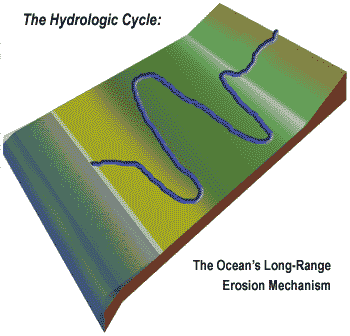
The outpouring of life from the water to the land would not have been possible had the sea, through the hydrologic cycle, not provided a precedent. Water; composing almost 70% of our human bodies, literally flows through our veins. Thus, for all our reliance upon atmospheric gases, we remain, in a sense, marine organisms. Until the moon landings of 1969, life had gone nowhere that water had not gone before and, even then, water came along for the ride.
The continued presence and influence of our ancient, oceanic heritage becomes all the more apparent the more we investigate the chemical dependencies of life and the interactive relationship between land and sea.
Standing in view of the pounding surf, or watching helplessly as seeping, saline ground waters, slowly erode fertile coasts, it is all too easy for us to judge the ocean’s impact as irredeemably negative. Soils that sustained plants, animals and humans, once stolen from the land, sink to regions where only kelp and corals benefit. Yet, even for the seaweeds, the gift is fleeting, for, in short order, the fertile soil slips beneath the waters’ euphotic zone (the surface region of the ocean that sunlight penetrates) and descends to depths where photosynthetic processes cease — and life, all but ends.
This negative view, however, comes of our tendency to picture the earth’s history from our apparently static viewpoint. When seen from a holistic perspective, the ocean reveals its true self: the source of all the earth’s fertility.
Already described in this essay are the positive effects of the hydrologic cycle, which makes possible the redistribution of minerals and nutrients. What has not been noted explicitly however is that these effects are accomplished by a force that is inherently erosive in character.
Rivers, despite the attention given them in this essay, are little more than the ocean’s proboscis upon the land – giant, amoeban arms, pawing at the continental earth in an eternal effort to return all to its liquid origin. The riverine deposit of soil, mineral and nutrient, is a consequence of the limited potency of this energy to accomplish its long-term erosive goal. Any respite afforded to transported material is always, only temporary. Ultimately, it is in the deep that all earth finds its end.
If rivers then, are the grasping arms of the sea, the surface waves and deep-water currents are its teeth. The erosive powers of the hydrologic cycle exceed those of waves only in reach. In strength, they cannot compete with the direct forces with which the ocean unrelentingly batters both shore and shelf. Yet, just as river erosion has its positive effects, so too does the erosion of the land by the sea.
Right now, off our modern coasts, land is slowly being stripped away and deposited on the sea floor. There, wave action, and the constant flow of near-shore currents, sifts and sorts the eroded soil both horizontally and vertically. The heaviest, most infertile sands remain near the beaches, while the lighter, more mineral-rich soils are transported far from the shoreline. When gravity lowers even these to the ocean floor, the particles arrange themselves in layers of increasing fineness from the bedrock upwards.
This process is comparable to the transportive properties of rivers, though it operates on a far more massive scale.
Much of this soil is destined to be lost to the deep ocean for eons of geological time; but not all of it. Where the continental shelf is sufficiently wide and flat, it acts as a catchment of sorts. Here, the silt settles into sinkholes and depressions in the surface, or spreads out finely over the shelf floor. Over time, the shelf will integrate much of this new material within its petrified sediments (which are formed of just these same materials, deposited over eons of geological time).
Of course, unlike silt deposited on the banks of the world’s rivers, silt that settles on the continental shelf, is beyond human exploitation. Yet, as we know, this is not destined to always be so.
The Eemian Interglacial period lasted approximately 30,000 years, and throughout that period, waves beat upon a shoreline that, in altitude, was approximate with our own. The elevated continental crust became grist in the ocean’s pounding mill for thirty millennia; its rocks, sands and gravels were ground ever finer, and were moved ever further toward the outer rim of the continental shelf. When the Eemian ended, the retreating water unveiled the result of its labor: perhaps the most finely milled soils anywhere in the world.
In the first part of this series, it was suggested that the periodic flooding of the continental shelf over multiple Inter-Glacial periods might have introduced unique properties within soils exposed during Glaciated conditions. Thus far, I have described how changes in ocean depth facilitated the effective distribution of valuable, eroded silts over the periodically flooded plains, and delayed the eventual decent of these fertile soils into the ocean’s desert deeps.
The appearance of marine deltas, during periods of ocean flooding, concentrated riverine silt deposits at the inner rim of the shelf for slow redistribution over the plains during glacial periods. Under low water conditions, the slackened pace of rivers flowing over the shallow incline of the continental shelf, allowed for the formation of massive, riverine deltas (similar to the Mississippi Delta of the Holocene). Finally (as described above) the pounding surf of floodwaters directly eroded the inter-glacial shoreline while bottom currents pushed finely ground sediments toward the continental edge.
The potential of these forces to infuse the Ice Age coastal plains with fertile soils certainly appears significant. Nevertheless, this essay has yet made no mention of what direct effects the periodic presence of 120 meters or more of water depth above much of the continental margin may have had upon the sediments formed below.
To understand the hidden potential of oceanic floods of this magnitude, we need look away from the oceans to some of the few places on earth where ground lain down under similar conditions may yet be found exposed in the Holocene world — the last place we would think to find it: the earth’s mountain ranges.
On the slopes of mountains, hikers and climbers often stumble upon the fossilized remains of shellfish and other crustaceans. Such marine sediments were once thought to be evidence of “Noah’s flood.” Now we realize that these remains were deposited millions of years ago, when much of the world that is now continental landmass rested at the bottoms of vast oceans. Massive earth quakes and slow tectonic movements of the earth’s plates subsequently lifted some of these seabeds even to extreme altitudes.
It so happens that these marine deposits represent some of the world’s richest sources of a specific chemical compound of infinite value to all life on earth: phosphate.
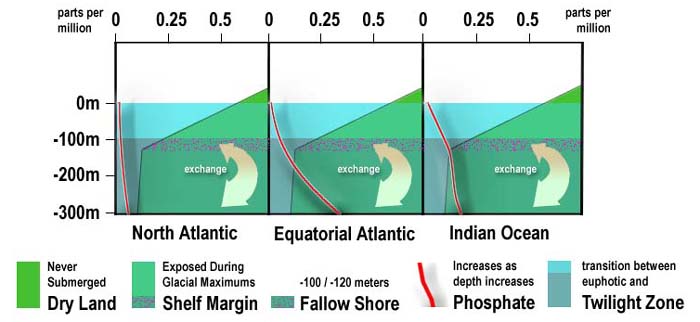
A large part of the reason that rivers have historically been of such value to agriculture is the transport and distribution of natural phosphates that they facilitate. Eroded from ancient marine deposits by mountain streams, phosphates are delivered by rivers to the plains below, where they are deposited on the riverbanks by seasonal floods or artificial irrigation. It would not be an exaggeration to characterize Ancient Egypt as the offspring of phosphate deposits, carved from the mountains surrounding Lake Victoria.
Aside from water itself, no chemical element is more essential to plant life than phosphate. Its value cannot possibly be overestimated. The presence or absence of phosphate in soil is the principle factor by which its fertility is determined. Even the most irrigated and otherwise nutrient rich earth, if devoid of phosphate, will yield no plant life whatsoever.
Marine organisms, sitting at the gravitational bottom of the chain of life descending from the mountain peaks to the sea floor, are the last to make use of these compounds. What they fail to recycle sinks to the bottom as phosphate nodules. Under the right circumstances, these nodules will build up into sedimentary layers of nearly pure phosphate.
Miles below the surface of the ocean, a constant rain of biological material coats the lightless, barren ground in thick ooze. These soils, despite their enormous phosphate content, are out of reach of exploitation by all but bacterial life and are destined to lay fallow for millions of years (until far distant geological forces uplift the ocean floor to form new continents).
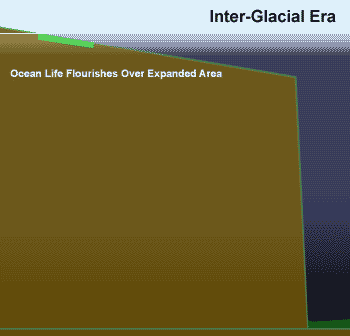
All of the biological rainfall that coats the bottom of the sea is produced by life forms inhabiting the ocean. Aside from alga fields that drift upon the surface, all the ocean’s first order biological activity is restricted to the very narrow margin of waters that wash the continental coastline. Beyond this margin, the ocean’s depth shields the sea floor from the penetrating sunlight needed for photosynthesis. Without the plant life that sunlight makes possible, the entire food chain collapses into an ecology characterized by single-celled organisms and other simple life forms, feeding on waste material drifting out from the shallows.
The Euphotic Zone, the watery region where photosynthesis remains possible, descends to a depth of roughly 100 meters, though some limited photosynthetic activity may take place a short depth below this line and much of it ends far above it.
During glacial periods, the waters of the ocean practically lapped against the outer rim of the continental shelf. Not far from this glacial era coast, the land dropped very rapidly over a submarine cliff edge. Consequently, marine biological activity was concentrated in an even narrower strip than it is today and it’s waste material, was quickly dumped to extreme depths.
In inter-glacial priods, two related phenomena insured that the desent of this biomass was not so rapid.
First, the shallow, flat shelves supported a wider expanse of marine biology. This insured more recycling of biomass by renewal of the submarine soils. Fertilizing compounds, drifting out from the beaches, settled on ground still suitable for plant growth. Thus, the local ecology retained the valuable nutrients contained therein, and slowed their eventual loss from the earth’s life-cycle.
Secondly, and perhaps most importantly, during inter-glacial periods, the ocean bottom was effectively lifted to a mere 20 meters below the Euphotic zone. Though biological waste materials from the coasts continued to spill over the cliff face of the continental shelf, much of it was thus retained on the cusp of the margin itself, and in a fallow state. The vast, plant free ledge that, in places, extended out and under the Euphotic zone for miles, thus captured a good portion of the phosphate rich, biogenous ooze that would normally have sank directly to the ocean bottom. The resulting fertilization of the shelf with biomass persisted for tens of millennia. The depth at which this retention occurred – somewhere between the outer limits of vegetative photosynthesis and bacteriological purification – insured that the phosphate-infused soils would lie unexploited throughout that time.
Another phenomenon of interest augmented the effects of biomass retention afforded by the flooding of the continental margins.
During both glacial and inter-glacial periods, deep, turbulent currents, passing along the bottom of the shelf edges, disturbed ocean-floor deposits of undeterminable age – deposits mixed in a thick soup of biological waste material that had poured for millennia, in a slow but steady stream, down from the high cliffs above. Those deep currents crashed against the barricades of the shelf margins and “up welled” this material in wave-like thrusts.
In glacial periods, because water depth above the shelf was so shallow, and the shelf margin itself so thin, most of this mineralogically invaluable material immediately drifted back down over the cliff face, lost again to the depths. But during Glacial periods, these deepwater currents had room to crest over the lips of the cliff faces and spill their material directly on the continental shelf.
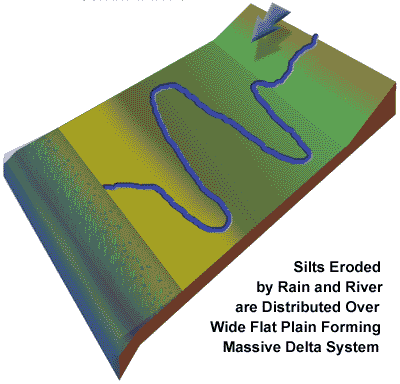
Thus, a unique mix of fertility-boosting forces combined on the continental margins during periods of inter-glacial flooding. From the shoreline, river silts, together with soils eroded from the shore by wave action, were refined, and conveyed by currents toward the outer margins of the shelf. At the same time, biological material, produced in exceptional abundance, slowly made its way through the local ecology to sink and lie fallow on the same shelf margin. A third wave of ancient mineralogical and biological material, up welling from miles below the water’s surface, collided with both these forces.
Of course, a great deal of the phosphate-rich, finely milled mineral ooze, produced by this combination, was eventually lost to the depths. Nevertheless, where the continental margin was of sufficient size, much of it was retained. Eventually, the sediment of the shelf incorporated much of this mixture. The remainder rested upon the surface in the form of rich alluvial soils.
It is the suggestion of this paper that, when the last great Ice Age began, and the Eemian inter-glacial floods receded, the coastal flats thus exposed were home to the most fertile soils the world has ever known. Furthermore, because of the current-driven distribution of the formerly submarine materials, the best of these soils were concentrated at the Ice-Age shoreline.
The Eemian, of course, did not alone create this happy-assembly. Rather, the last inter-glacial merely produced the latest inundation in a cycle spanning hundreds of thousands – and perhaps millions – of years. Each of these floods left similar deposits on the shelf and, over time, this material became a permanent fixture of the shelf’s sediment.
In human memory, soils such as these have never been equaled.
When we emerged from Africa, in the last great exodus from that continent, a lush but doomed, “Garden of Eden” awaited our arrival; and beckoned us to tarry there, along the coastal plains.
Next week, in the final part of this series, Christopher e/xamines what implications the “God’s Garden Hypothesis” might have upon theories of agricultural development – and how these square quite nicely with Underworld’s settlement scenario.
In the long-awaited, final installment of his God’s Garden series, Christopher Ash demonstrates how Graham Hancock’s “Lost Civilization” accords well with some major
theories by which the origin of agriculture has been explained. Furthermore, those theories receive additional support from (and thus perhaps imply) the presumed
existence of a “Lost Civilization” in pre-history, a postulate advocated by Hancock in his latest book, “Underworld.”
Part 5: Feast or Famine?


Nowhere in the world are there any signs of agriculture during the 100,000 years prior to the Holocene but, suddenly, with the close of the Ice Age,
agriculture is everywhere. Why?
Lewis Binford was the first Anthropologist to trace the
origin of agriculture to the rise in sea level that occurred at the close of the Ice Age. According to Binford, agricultural methods were developed, not as the
consequence of coincident climate change, but as the result of population pressure induced, in part, by
the forced migration of post-Ice-Age refugees from the coasts.
Binford even went so far as to speculate that some of these displaced communities might have formerly been
“relatively sedentary” and maritime in character.
If Binford’s migrants really were the originators of agriculture, they make a good match with Hancock’s lost maritime civilization, also said to have migrated from
the coasts to the most fertile regions of the post-flood world. Hancock, in Underworld, also notes the proximity of many early centers of agriculture to those areas
of major inundation identified by
Geologist Glen Milne’s computer models of Ice Age flooding.
The models of civilization’s development proposed by Binford and Hancock, on the surface, appear to differ only by degree: the degree to which the culture of these
hypothetical, Ice Age maritimers was sedentist and incorporated recognizable
trappings of “civilization.” Binford would no doubt err toward a conservative picture
of the past, in keeping with traditional images of hunter-gatherer society, while Hancock encourages us to entertain more radical possibilities (Binford, for
instance, would probably object to this essay’s general thrust, as
he was ontemptuous of any notion that a “Garden of Eden” inspired original
sedentism).
The truth is that Hancock and Binford differ fundamentally. Binford’s
“Functionalist Model” remains largely consistent with the
views of most anthropologists: that
“civilization” arose as a consequence of agriculture’s development. Hancock seems to suggest the very opposite: that agriculture arose in response to civilization’s
collapse.
The scenario Hancock seems to envision in his latest book Underworld (though it is nowhere made explicit), is one where the descendants of his Ice Age maritimers (like those envisioned by Binford) devise agriculture in response to the loss of the lands of the continental shelf, whilst their Ice Age progenitors relied on agriculture for not but the most marginal, supplemental resources: that is, medicinal plants and delicacies.[1]
Despite the central role played by agriculture in the conventional understanding of the story of civilization, Hancock, in Underworld, devotes a surprisingly small amount of space to its discussion. One gets the feeling that Hancock is not a little bit uncomfortable with the subject. His avoidance here parallels his earlier-noted reluctance to provide explanations for his hypothetical civilization’s settlement patterns. Hancock seems cognizant of the fact that his grand thesis is most open to challenge in these two areas and, not having any easy answers, he tends to avoid these difficult questions.
Hancock is very honest with regard to the settlement problem, openly confessing his inability to explain why his proposed civilization settled where it did, but he is less forthcoming when dealing with the problem of the origin of agriculture.
The lack of agricultural technology during the Ice Age poses a problem to Hancock because, without it, it is difficult to see how substantial, urban communities could have been possible.
It is a truism of anthropologists that agriculture is a prerequisite of sedentism; that, without agriculture, a nomadic lifestyle is mandatory. This, however, is an overstatement. Urban community requires only a renewable, local food source, in supplies sufficient to reliably sustain a fixed and contiguous population. The source and means of supply would seem immaterial.
Agriculture, as a means of sustenance, is a specific technology by which quantities of food are induced from the soil in excess of that which the soil produces of its own accord. As such, it is an artificial means of generating a renewable, local food source. It cannot be said that, by definition, a non-artificial (that is, natural) means is impossible, though such a means be unknown or undiscovered. Were natural soils capable of generating such a food supply, urban communities could develop (indeed, they might be expected to) without recourse to agriculture.
Therefore, two choices are open to Hancock. He can challenge the accepted chronology of agriculture or he can propose some alternative means by which sizable urban communities might have been sustained in the Ice Age world. Unfortunately, in Underworld, he does neither.
What Hancock appears to see as his thesis’ weakness (consequently giving it scant treatment), may actually be its greatest strength. His implicit proposal that agriculture was unknown to his hypothetical “Lost Civilization” constitutes the first characteristic ascribed to that ancient culture by which it may be differentiated from all (or most) communities of the Holocene world. As such, this characteristic might serve to explain the idiosyncratic settlement pattern he ascribes to these ancient mariners (that is, their confinement to specific coastal territories) for, in all human social groups — both nomadic and sedentist – settlement patterns are dictated by modes of sustenance.
Not too long ago, most anthropologists assumed that humans developed agriculture in response to deprivation. What might be called the “Garden of Eden scenario,” handed down to us through Judea-Christian mythology, placed the first humans within an abundant natural world that later fell into deprivation and decay, thus forcing our first parents to turn to the tilling of the soil. This view seems intuitive and, for long, scientists who considered the problem of civilization’s origin supported it. British anthropologist V. Gordon Childe, who in 1925 coined the phrase, “Neolithic Revolution,”
imagined an original fertile world that was later struck by an Ice Age,
prompting the development of agriculture in response.
There are today still some anthropologists who argue for a similar model, but the temporal windows and geographical regions into which they place their “golden age,” have grown progressively smaller. The reason being, we now know that for most of the time in which Homo Sapiens Sapiens inhabited this planet, the world was in a deep freeze. Thus the hypothetical Eden gets shoehorned, into theoretical “Oases,” snuggly between the Ice Age and the Younger Dryas (11,000 to 10,000 BP) – the latter period bringing
a sudden and disastrous cold-snap to the general warming trend of the early Holocene.
Today, most anthropologists see
the available evidence running contrary to this “Oasis Theory.”
The climate preceding the Younger Dryas appears insufficiently superior to that of the evolving Holocene to have inspired any myth of a golden age or to have afforded natural food stuffs in any quantity greater than those available in our modern world. Rather than for the worse, conditions seem to have taken a drastic turn for the better at precisely the moment that agriculture got off the ground and, ever since, the world climate has tended to generally “improve.”
Nevertheless, Childe and his supporters just may have things right; at least, partly so. After all, his model makes such good sense.
Imagine three playing cards.
On the first card is written the phrase, “Need for Surplus,” on the second, “Agriculture” and on the third, “Urban Community.” Each card represents a stage in the development of a hypothetical civilization. The “Need for Surplus” card signifies some want for a food supply greater than that which is needed to meet the immediate needs of individual members of the community; the “Agriculture” card refers to the development of agricultural technologies; and the “Urban Community” card represents the emergence of a fixed, local, contiguous population.
Asked to arrange these cards in chronological order (that is, the order in which each stage is encountered by an emerging civilization),
which ought to be placed first? Which last?



Or Perhaps…



Or some other combination?
If one begins with a presumed need for surplus, how is this need explained without the pre-existence of an Urban Community? Why would nomadic hunter gathers ever desire a surplus?
On the other hand, if one explains the need for surpluses by beginning with an Urban Community, how is the rise of the latter explained in the absence of Agriculture?
This conundrum has led some anthropologists to introduce what might be called, in keeping with this thought experiment, a “Wild Card:” Chance Surplus.




This model proposes that the first surpluses arose by chance, in separate locations all over the world, once the earth’s environment became amenable to their occasional generation at the close of the Ice Age.
This currently quite popular model goes something like this…
- [Chance Surplus] Nomadic humans, accidentally discharge gathered fruit and vegetable materials near the seasonal settlement. During the Ice Age, the germination of these seeds is unreliable, due to unpredictable climate conditions (thus for millennia, the accident leaves no lasting cultural effect). Once the climate stabilizes however, at the beginning of the Holocene, such randomly discharged seeds begin to sprout reliably, year after year.
- [Agriculture] This happy accident makes the gathering of resources in subsequent years easier and the “harvest,” more abundant. Resourceful and inventive humans notice the natural process and begin to repeat it with intention.
- [Urban Community] Soon, many communities no longer need to migrate in search of food but, through the mastery of storage techniques, are able to survive in a fixed location. Moreover, an aristocracy of supervisors emerges, necessary to organize the collection and storage of food reserves.
- [Need for Surplus] The adopted sedentary mode of living, an “Urban Community,” demands a continuation of the agricultural habit – permanently locking civilization into the cycle of planting and harvest.
This may well be an accurate model. However, a number of objections are immediately obvious.
First, the model requires of the Ice Age,
a climate so harsh as to render impossible the reliable generation of chance
surpluses anywhere in the world. To some extent, the climate data provides support for the assumption in the broad sense – however it is somewhat problematic to argue, and difficult to confirm, the universal presence of such conditions for tens of millennia. Though possible, it seems unlikely that no place on earth provided a suitable region for reliable cultivation cycles, regardless of the broader climate.
Second, the model requires that a complex interaction between the natural world and human ingenuity take place almost simultaneously, for many distinct peoples all over the planet. While isolated cultures might occasionally develop in parallel, it stretches credulity to imagine multiple parallels, of such complexity, occurring in near perfect synchronicity.
Third, this model fails to explain the process of domestication, which by definition,
implies the movement of plants from one environment into another.
Where a foodstuff easily grows with abundance, domestication is unnecessary (and actually, impossible). It is only when a plant (or animal, for that matter) is moved
to an environment generally inhospitable to its reproduction that humans need to intervene in the process of regeneration. In an environment naturally conducive to a particular plant’s growth, no change in the plant genome would
occur. [2]
The only alternative to transplantation is climate change, which might then prompt already sedentary humans to intervene in the maintenance of plants, now endangered
by a suddenly upturned environment. Unfortunately, this apparent “solution” would make a chaotic climate, rather than a stable one, most conducive to encouraging agricultural technologies.
A fourth objection is fundamental.
Recent anthropological studies of ancient human skeletons indicate that reliance upon agriculture had a generally negative impact upon human health and life expectancy. Other studies suggest that, in contrast with hunting and gathering, agriculture required longer hours and greater physical effort to provide just simple sustenance. This evidence strikes at the very heart of the model’s primary assumption: that the proximity of artificially induced growth made resource gathering easier. It simply did not.
Yet, perhaps the biggest difficulty existent in this model, and all others that rely on climate change to explain the rise of agriculture, is found in the notion that
sets the foundation for the theory: that the Earth’s climate, at the end of the Ice Age, somehow “improved.”
If we accept this proposition then we must also accept a rather strange set of circumstances for Homo sapiens as a species.
Apparently, for fifty to a hundred thousand years or more, modern humans dwelt on a planet with a climate so
“harsh,” “desolate” and “chaotic” that plants suitable for human consumption could be made to grow reliably neither by fortunate accident nor by force of human will. Then, when the environment finally “improved,” rather than taking advantage of the vast expanses of new and untouched natural food resources awaiting nomadic exploitation, human beings, en mass, switched to a less-healthy and more-difficult form of sustenance – one which actually required some ingenuity to invent.
To put it bluntly, this does not make the least bit of sense.
The peoples of the Ice Age, who are said to have endured a chaotic climate that propelled them from region to region in a never-ending search for food, should have most appreciated agriculture. These were people who would have truly benefited from a technology by which reliable surpluses might have been generated on demand. Yet, they did not pursue such technologies. Instead, the inventors of agriculture were the people of the climatically stable, Holocene world: the inheritors of vast, unexploited and newly fertile lands, ripe for nomadic exploitation.
Impossible for those who needed it most; inevitable for those who needed it least: such is the paradox of agriculture when its origin is made dependent on
climate change.
Arguments, such as this, that rely upon posited impossibilities for human beings, are inherently weak (human ingenuity being what it seems, should our ancestors have wanted to grow potatoes on ice caps, surely they would have devised some method of doing so?). Stronger arguments are founded in human need. Thus, the failure of agriculture to emerge in the Ice Age has one obvious though ill-considered solution: it was not needed
Agriculture, like all technology, is unlikely to have emerged in a world in which it had no benefit to confer. History records many frustrated inventors who gave the world fascinating devices that, though technically ingenious, were left unexploited, simply because the tool met no apparent need within the wider cultural context.
Thus, the development of agriculture, if it follows the pattern established by historical technologies, presumes a preexistent unmet need for surpluses. One can generate as many chance surpluses as one likes but unless those surpluses appear in a society with a pre-existent need for surpluses, they will never lead to agriculture. The solution cannot precede its need.


Where do the other “cards” fit in?
Borrowing the anthropologist’s “Wild Card,” the deck may now be slightly rearranged. Retaining the accidental surplus as the starting point, we proceed first into urban civilization, then into a need for surplus, and finally, the development of agriculture, as a response to this need.




Here is how the model works.
- [Chance Surplus] Human society begins in a uniquely abundant environment that generates surpluses without any artificial inducement.
- [Urban Community] This circumstance of natural surplus gives rise to Urban Civilization in its midst – and does so immediately.
- [Need for Surplus] After some millennia of social stability, the natural food supplies deteriorate – either gradually or catastrophically.
- [Agriculture] In response to this change in the environment, adaptive and resourceful human beings invent a technological means of generating the surpluses upon which they have come to depend.
And thus we return to Childe’s “Oasis Theory,” which would seem a good model were the primary objections answered: a suitable location for the first such communities proposed, and the temporal restriction on the fertile period expanded (it being assumed the 1,000 years of warm and wet, prior to the Younger Dryas, too brief and too limited in direct impact to have fostered global cultural change).
Being in precisely the right place (globally) and available over precisely the right time, the outer margins of the continental shelf, exposed exclusively during the long, glacial period and submerged at the beginning of the Holocene, suggest a solution to both problems. The temporal pattern of shelf exposure exactly parallels that of agricultural development: at no time while the shelf is exposed do we find evidence of agriculture and immediately after the shelf is submerged we find agricultural technologies appearing over the whole of the earth.
On first glance, it is tempting to conclude that these apparently correlating phenomena are but twin effects of a single, primary cause: that is, the same warming that melted the Ice Caps also made the climate sufficiently stable for agriculture. This has generally been the assumption
of anthropologists interested in the subject.
There is another possibility however. Rather than being its sibling, the rise in global sea levels, fostered by climate change, may be, as Binford suggested, the direct parent of agriculture.
This essay has presented a case for the existence, during the Ice Age, of a world characterized by concentrated bounty. If the hypothesis regarding the high productive capacity of certain flat, lowlands, lying below the Eemian/Holocene waterline holds true, there is every reason to suspect that this land was capable of naturally generating reliable foodstuffs even in the context of a chaotic global climate.
If so (and admittedly, that has yet to be conclusively established), climate change is probably the wrong place to look for clues to the origin of agriculture. It is more likely that loss of habitat provided the impetus for this behavioral adaptation of Homo sapiens.
Thus a radical new view of human pre-history emerges: one where the fertile continental shelf becomes the “natural habitat” of our species (and perhaps of all Hominids) and Urban, sedentism becomes
our natural state (rather than hunting and gathering, which has been grossly exaggerated in scope by studies limited to what were inland areas during most of
pre-history).
It was already-settled lowland communities that were displaced by the floods of the early Holocene, and already urbanized migrants who made their way to the higher ground of inland regions. Having lost access to the only soils on earth capable of sustaining settled communities with natural surpluses, an adaptive mechanism was required to extract, from the comparably infertile inland soils, quantities of food those soils were incapable of producing in the absence of human intervention. The adaptive system our ancestors devised was agriculture. Transplanting themselves; they too became a domesticated strain: of Hominid.
This new “flood model” of agricultural development requires two things: regions of abundance on the Ice Age continental shelves (a case for which, this essay has endeavored to make) and, sustained by those resources, sedentary human communities of some size, capable of organized adaptive efforts. These communities need not have been large nor need they have been “advanced,” in the sense in which that term is normally employed. They need only have been non-nomadic fixtures on the landscape, unaccustomed to a nomadic lifestyle and thus eager to develop a technology to allow for the maintenance of the sedentary existence to which they were inclined.
Unfortunately, we still lack evidence for the existence of these communities. However, if the thesis outlined in this essay has any validity, this can no longer be characterized as surprising.
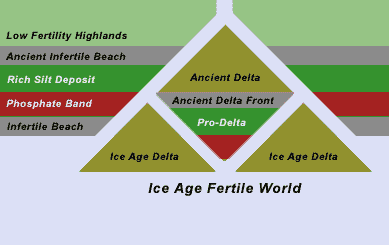
outer rim of the shelf. Thus it is likely that excess population, rather than moving upriver, followed the path of least-resistance along the coasts, moving laterally
inline with the narrow vein of fertile soils running along extensive but limited stretches of the shoreline.
If anthropologists are correct in concluding that agriculture was unknown to the pre-Holocene world, urban communities would have been virtually impossible above the Eemian/Holocene waterline (as they are, in fact, impossible today – in the absence of artificial methods by which the carrying-capacity of the local soils may be increased). As for the continental shelf, the data is insufficient to reach any conclusion regarding its natural carrying capacity. However, the argument presented elsewhere in this paper suggests there is every reason to suspect its capacity was significantly higher than that of any known natural soil.
If Urban Communities existed during the Ice Age, there is only one place on earth in which they could have done so: the coastal margins. Moreover, the existence of such communities would provide a simple and elegant explanation for the origin of agriculture, allowing for the marriage of “Oasis Theory” with “Functionalist” Push/Pull Models.
It is somewhat surprising to find, now united, the seemingly competing theories of two of the 20th century’s most-influential anthropologists. It is even more disconcerting to realize that this union is made possible by the postulate of an Ice Age “Lost Civilization,” such as proposed by the unlikely Graham Hancock.
Conclusion
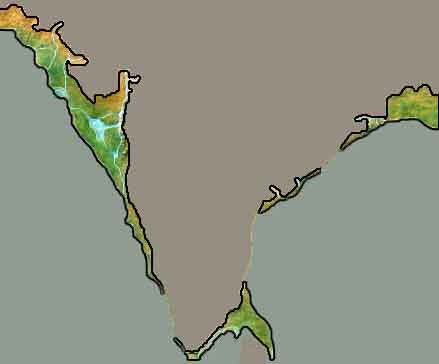
Is this how the ancients understood the ‘Habitable World?’ In the absence of agricultural technologies, Ice Age India might have appeared an
archipelago of fertile “Islands” floating between two barren seas: one of water and one of earth.
All attempts to explain the rise of agriculture in human society, by climatic models, have assumed that the end of the Ice Age produced conditions more suited to sedentary farming – while the harsh and chaotic Ice Age world limited the availability of arable lands, making domestic food production impossible or less productive.
These models are all quite interesting. However, they are also all quite inadequate – for reasons outlined. These models are also completely at odds with everything our ancestors have ever told us about our past. Advocacy of such models requires a complete disregard for this ancient testimony.
Once there was an Eden – so the story goes — and, in that Eden, no man neither tilled the soil nor lived by the sweat of his brow. There, in that more-perfect place, the gods planted a garden and made available to our first parents every good thing.
Once there was a “First Time” — so the story goes – when gods shared with us the earth in harmony, and there was no war and no discord between men.
Once there was an Atlantis — so the story goes – and in that country, every good and perfect fruit and vegetable grew in abundance, without need of cultivation.
The ancients saw the history of their world as split violently in two by a thin demarcation line. On one side was a golden age, on the other, a world of endless effort and misery. These stories leave no room for doubt regarding their interpretation: the best the earth had to offer is now lost forever and all that man has achieved has been accomplished against a backdrop of deprivation.
Today, we presume that the climate of planet earth represents the best of all possible worlds; that any aberration from our modern ideal must have detrimental effects so far as humanity is or was concerned. We worry about the planet getting “too hot” or “too cold” as though, like some collective “Goldilocks” sampling varied bowls of porridge, our species happened to stumble upon an ecology that was “just right,” at the end of an eon of unsatisfying climatic sampling.
The odd thing is; if species are endowed by evolution with traits especially adapted for their environment, then our species must best be adapted to the Ice Age – not to the Holocene. It was the Ice Age that gave birth to us and it was the Ice Age in which we thrived for the greatest breadth of our history on this planet.
Modern scholars, to describe the conditions of that lost world, use words such as “harsh” and “desolate,” without ever stopping to ask why modern Human Beings could evolve in a world so unsuited to their presence. The testimony of our ancestors, however, is that such words more aptly describe our present.
Surprisingly, this testimony accords well with the evidence of modern science. If we examine the history of the planet over the past 500,000 years or so, our current epoch is clearly the aberration. The deviant climatic periods are ones such as in we live. While we speak of ages of “Ice,” we ought to speak of ages of “Fire.”
Such is the Holocene.
In that light, all of recorded history appears in the context of an ongoing disaster – one from which our Earth has not yet recovered. That disaster was the sudden and dramatic loss, not of the planet’s “ice sheet,” but of its ice shield.
Civilization had once a cradle, but from it, humanity was pushed violently and irrevocably. Agriculture arose, not because humans were able to take advantage of a
suddenly improving climate, but because humans were desperately struggling to survive in an environment so alien, we must be forgiven for failing to recognize it as our own. We are but accustomed to our condition: mistaking famine, for feast.
Footnotes:
-
I find it an alluring thesis that the first uses of agriculture may have been for reasons other than food production. I suspect that
Bronson and Sauer (and others)
are on to something by emphasizing the
medicinal and social applications of agriculture.If humans were domesticating animals for a 100,000 years before they ever ate one of their domesticate breeds, and were possibly domesticating plants for medicinal and social purposes for nearly as long, it begs the question as to why they never bothered to use either technology to increase the food supply. For me, the obvious answer is that they did not need to. Their food supply was already more than adequate.
Moreover, I suspect it most likely that the food supply was generally more than adequate for some millions of years.
I cannot help but note here what appears an interesting aspect concerning human nature: we don’t like to eat things we know on a first name basis
(even canibals seldom hunt their own tribe!).As a child, I would help my father hunt rabbits, and would later help eat them when my mother served them for supper. Yet, I would never consider eating a pet “bunny.”
In fact, it is rather interesting that the closer an animal resides to the dinner plates, the less likely it is to wind up as dinner. On the farms I visited as a child, the cats were in the house, the dog in the yard, the horses in the barn next door, and the chickens in the coop. Wandering way out on the Pasteur were the cows.
The same process even appears with plants. Roses are in a vase on the dining room table. Other flowering plants are on the front porch. A hedge fences the front yard. Way in back, near the compost heap, the future meals grow in the dirt.
Animals destined for slaughter are seldom spoken to or given names. As for plants, those that are brought in-doors are often directly subjected to human conversation!
This “evidence” (though it hardly qualifies as such) suggests to me that human beings are uninclined to domesticate (introduce within the environment of the “domicile”) animals or plants desired for food sources. To the contrary, for reasons mysterious, we are most inclined to domesticate animals and plants for the most impractical “reasons.” Of what use is a potted plant? How does a pet hamster increase the carrying capacity of the local environment?
Thus, it fails to surprise me that the dog was domesticated thousands of years before the pig. And I expect the same kind of ancient pedigree will eventually be found at the root of plant domestication as well.
This suggests that nature, for millions of years, could afford hominids the luxury of expending time, energy and resources on animals that could not be eaten and, possibly, plants that depleted the soil. This apparent instinct to care for other species, without thought to their eventual exploitation, cannot be explained in the context of environment characterized by scarcity.
For me, there is but one conclusion: Homo Sapiens have evolved for an environment with more than enough food to spare. The surplus has always been with us.
The clear but overlooked implication is that agriculture is likely a product of migrants; who bring with them plants, unadapted to the local environement.






